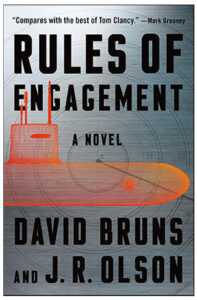
We welcome David Bruns and J.R. Olson to answer some questions about their novel, Rules of Engagement. The book deals with cyberwarfare, as the Internet Age offers a new front in global conflicts, one that is rewriting history as you’re reading this page. Think how the ironclads USS Monitor and CSS Virginia (Merrimack) clashing in the Civil War rendered wood-hulled ships obsolete, or how tanks rolling onto the Western Front transformed in the First World War and radar did the same in the Second.
Winston Churchill said, “The empires of the future are the empires of the mind,” and that’s why co-authors David Bruns and J.R. Olson are here to imagine how World War III might unfold on these new frontiers where digital bullets fly across the world at the speed of thought. The co-authors are both graduates of the U.S. Naval Academy and creators of The WMD Files series of national security thrillers.
David Bruns was an officer in the submarine force and J.R. Olson served more than 20 years in the U.S. Navy, retiring as a commander. He now teaches college courses in Intelligence and Counter-Terrorism. Both authors call Minnesota home. They have collaborated on previous works and published numerous solo projects.
THE HISTORY AUTHOR SHOW: First, thank you both for your service in the United States Navy, and now for putting your knowledge to work in a way that reaches the public through fiction. When I worked in TV news, they wanted us to avoid terms like “teach” and “learn,” but Rules of Engagement proves you can do both and still entertain. But sharing what you know brings challenges. What’s the process for ensuring you don’t reveal too much inside knowledge?
David Bruns / J.R. Olson: We’ll say this right up front: Rules of Engagement is not a how-to manual. If someone buys our book thinking they are going to plan a cyberattack, they’re going to be disappointed!
Although we both held high-level security clearances during our time on active duty, we gave up those privileges when we resigned our commissions. All of the operational details in our stories are sourced from reputable, publicly available sources. In the event we might know classified details about a piece of equipment, for example, we will always downgrade the capabilities to unclassified specifications. Besides, we want readers locked into the great story, not searching for details that are better found in a tech manual!
THAS: On December 7, 1941, First Lieutenant Kermit A. Tyler of the Army Air Forces at Oahu dismissed a large radar blip with the fateful words, “Don’t worry about it,” not recognizing it as the Japanese attack. J.R. Olson, you have a BS in history from Annapolis, and like your co-author, you both saw the world change during your tours of duty. What about this new frontier of warfare inspires you to write books like Rules of Engagement, imagining the future blips of a so-called Digital Pearl Harbor?
David Bruns / J.R. Olson: We’re in the very beginning stages of what the cyber domain means for the world. No one really knows where it will lead, though many have postulated some really thought-provoking ideas – artificial intelligence, robotics, and computers that fight our wars for us among many other options. It is already clear cyber is the fifth domain of modern warfare, the first four being ground, sea, air, and space. So, effectively mastering all five warfare domains ensures a nation can survive in a modern, full-scale conflict.
You’ll note that no nation is currently willing to pursue detailed treaties that limit cyber operations, including wartime impacts from cyber attacks. Why? Treaties require some level of disclosure and verification and why would any country want to limit the potential of cyber this early in the game? For the U.S., we have incredible tools we could use, running the gambit from covert action to full scale war. But, if we use anything today, including in the covert action arena, we run the risk of exposing our cyber capabilities to potential adversaries. Once that genie has left the lamp, you’ll never get it back, and the adversaries around the world will immediately have access to the code.

THAS: Thriller writer Tom Grace (in your neighboring state of Michigan) has guest hosted a few interviews for The History Author Show, and I had him on to discuss his most recent novel, Undeniable. Tom’s Nolan Kilkenny series also deals with technology that’s step ahead, so I asked him what question he’d put to you gentlemen about the real-world computer science behind Rules of Engagement. He said this: “Are the command-and-control systems of various nations’ militaries so similar that a single virus could be used to wrest control, or would attacks on each individual nation require a ground-up coding effort resulting in three (or more) unique viruses to accomplish this task?”
David Bruns / J.R. Olson: The short answer: we don’t know. We’re not computer hackers. Our guess is Tom Grace is right. Despite the fact that the Chinese have a history of industrial espionage attacks against U.S. defense contractors and reverse-engineering U.S. weapons systems, they would certainly customize their command and control system for their own use.
The fictitious computer virus we developed for our story incorporate sophisticated machine learning to teach itself how to take over the target system. Although we made a point of staying away from artificial intelligence (AI) as a plot device, you can imagine decade from now when a country like China sees the fruits of their multi-billion dollar investments in AI, how a single computer program might be able to adapt itself to infiltrate the command-and-control systems from various militaries. Kind of an unsettling thought.
Lastly, the idea of writing about a computer hacker writing code for each command and control system seemed boring to us, so we focused on how they physically break into each system, including one character who gets blackmailed into doing the bidding of the terrorist. 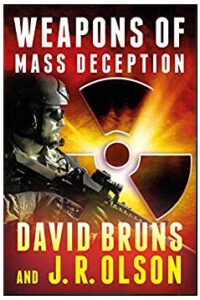
THAS: Graphic artist Peter Garceau designed the cover for Rules of Engagement. It’s industrial and retro, yet somehow timeless. It also features author Mark Greaney‘s high compliment that it “compares with the best of Tom Clancy.” The two of you have decades of experience at your fingertips that I’m sure Clancy would have envied — and perhaps he did when you met him, David Bruns. What are some common mistakes knowledgeable authors like yourselves are able to avoid, that make other efforts at fictional warfare fall flat? For instance, are there things in films, say, that just drive you nuts?
 David Bruns / J.R. Olson: Ask any veteran to watch a military film and they will give you a list of their pet peeves. We’re no different. In a guest post for The Real Book Spy, we laid out 6 Things We Love to Hate About Military Fiction. We covered military etiquette on saluting and use of first names as well as more serious topics like how PTSD is being treated in modern film and literature.
David Bruns / J.R. Olson: Ask any veteran to watch a military film and they will give you a list of their pet peeves. We’re no different. In a guest post for The Real Book Spy, we laid out 6 Things We Love to Hate About Military Fiction. We covered military etiquette on saluting and use of first names as well as more serious topics like how PTSD is being treated in modern film and literature.
THAS: The press material describes Rules of Engagement as a global story, which you’d expect from an imagined World War III. David Bruns, your bio says you visited “well over two dozen countries,” and you spent the twilight of the Cold War chasing Soviet subs around the North Atlantic. Jon R. Olson, you served in Iraq, Somalia, Bosnia, East Timor, Afghanistan, and had a stint as U.S. Naval Attaché in Finland. (You also trained with the CIA.) That’s about every corner of the globe except one: Deep inside North Korea, aptly nicknamed “the Hermit Kingdom.” How did you go about fleshing out that part of story, so it reads as real as the rest of the novel?
David Bruns / J.R. Olson: When we write together, JR does the lion’s share of the research and plotting. When David receives the “intel package” from his writing partner, it’s replete with pictures, maps, links to online videos and articles, and sometimes even chapter drafts with specific details to make things as technically accurate as possible. The most important part of any scene is setting the scene so the reader can get a vicarious experience and that comes down to sensory details. The upfront work done by JR lets David check those sensory boxes for the reader and anchor them in the story.
Also, there have been numerous documentaries on TV covering North Korea in recent years. So, yes, it is the “Hermit Kingdom,” but that kingdom has opened up a bit more recently, allowing people like us to absorb useful pieces of information about life inside North Korea.
THAS: I picked up a bunch of pop culture references in Rules of Engagement. Chapter 10 starts with three words alluding to the Simpsons: “Best. Thanksgiving. Ever.” Characters are apt to invoke Star Trek and Battlestar Galactica. As co-authors, how do you shake out those nuggets? Does your knowledge overlap, or does one of you handle the reference and the other weigh in on how they ground the story in the real world without being heavy handed?
David Bruns / J.R. Olson: These little call-outs are a product of our age and personalities as well as being touchstones for our core audience. They come out naturally in the first draft process for David, and when they both work on revisions, these sorts of details are debated—and sometimes redacted.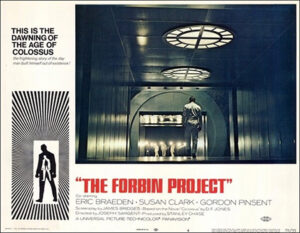
THAS: Your terrorist, Rafiq Roshed, designs a computer virus that “learns the art of war” and seizes control of the world’s largest navies. This reminded me of 1970’s Colossus: The Forbin Project, where Soviet and U.S. super-computers link in an effort to subjugate mankind to their Artificial Intelligence. Fifty years ago, that premise was science fiction, but we are rapidly approaching a day where AI will be a reality. With technology moving so fast, how do you ensure that after the time it takes you to research, write, and publish a book like Rules of Engagement, it’s still on the cutting edge when it hits bookstores?
David Bruns / J.R. Olson: Although our body of work speaks to the threats of tomorrow, the seeds of those future threats are all around us right now, well before they enter the popular consciousness. We credit JR for most of the “think-tank” work. Like a good intel officer, he consumes a vast amount of material every day and looks for patterns and themes that can be extrapolated into a narrative.
Rules of Engagement was actually written in late 2016, when the public discussion about cyberwarfare was barely making the news and the narrative about North Korea was “fire and fury.” In fact, the most common reason we got for a publisher rejection was the topic was “too timely.” Since it takes nearly two years for a major publisher to produce a book, they seemed very worried that Rules would be released into a much different world. Perhaps a world in which North Korea no longer existed!
THAS: In Charles Fishman’s One Giant Leap (check out the interview here, iHeartRadio, iTunes, etc.), I read that in 1969, even NASA couldn’t find a computer that would stay up and running for 24 hours without any downtime. Today, hard drives whir continuously like refrigerators, and we give them as little thought — until something goes wrong. Something went very wrong in 2003, when much of the Eastern Seaboard of the U.S. and Canada plunged into darkness.
Four years later, iPhones hit the Apple Store, presenting fresh security threats while making us dependent on a revolutionary technology. Can our cybersecurity defense capabilities keep pace with new vulnerabilities like these (by strategies such as banning Chinese-made Huawei cellphones) or do you foresee an endless supply of all-too-real plots for future novels?
David Bruns / J.R. Olson: Fun backstory: David was vacationing with his family in Niagara Falls in 2003 when the blackout hit…he’s pretty sure his then-two-year-old son had something to do with it.
Technological advances are and will continue to be a double-edged sword. There is no such thing as risk-free technology. The wonderful connectedness afforded by social media also influenced a US presidential election. For every positive use, someone somewhere will figure out how to use that same technology against their fellow man. As we see it, the real risk is a failure of imagination to see the possible consequences – good and bad — of technology. That’s where fiction has a place.
The short answer to your question: We see no end in sight of future plots for our national security thrillers.
If you want to feel even more unsettled, a story was just released about detection of a hacker group’s successful efforts (likely a front company for Chinese intelligence) to penetrate ten of the world’s larger telecommunications networks. The hackers were able to detect and track, and watch business and political leaders as they traveled around the world.
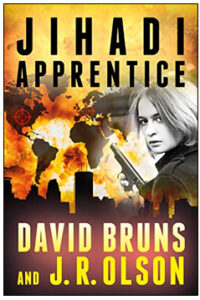
THAS: Rules of Engagement opens with the employee of a power plant opening an email that appears to be from his mother, not unlike how a phishing scam tricked former Secretary of State Hillary Clinton’s campaign chairman, John Podesta, into surrendering his email password. In fiction, there’s something called “the idiot in the attic,” where a character does something knowingly stupid (think horror movies where kids climb those attic stairs knowing Jason Voorhees or Freddy Kruger is up there). How do you design characters that make mistakes such as clicking that malware link, and keep readers sympathetic rather than rolling their eyes?
David Bruns / J.R. Olson: In a word, motivation. The reason why we feel for the employee in the power plant is that he’s going through a lot in his personal life. If your father was in the hospital dying of cancer and you got an email from your mom, you’d probably click that link too.
In modern day cyber security, the weak link is, without question, the human beings in the loop. Humans make mistakes – lots of them. Sadly, the many ways in which hackers or intelligence operations function today are tailor-made to take advantage of human frailties.
As you can read in the first chapter, those human mistakes can have significant, and potentially lethal, consequences.
THAS: The foes in Rules of Engagement set out to get his enemies to fight each other. This brought to mind the espionage virus Shamoon, and other tools used to cover a hacker’s track or leave fingerprints of another foe to throw investigators off track. I mentioned the swift flow of technology. It’s one thing to keep up with all the latest when it’s your career, but how do you go about ensuring you’re fully informed now as authors?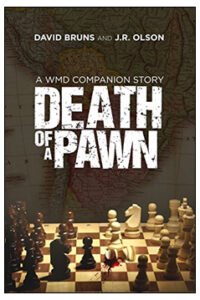
David Bruns / J.R. Olson: Since JR is a college lecturer in his day job, it’s his job to stay current on publicly available information. We do our research to make the material as authentic as possible and then focus on the story. If a reader is captured by the story, they will forgive a lot of hand-waving on the futuristic technical details. As we’ve said, we’re not computer hackers and Rules of Engagement is not a how-to manual for cyberwarriors.
The area where we will not compromise is how our characters react in the face of adversity. We have both worked with career military personnel and public servants and we insist that our stories have an air of realism to them. We don’t go for the “Hollywood hero” who never has to reload and never seems to run out of technical gadgets to get him out of any tight spot.
THAS: You have a character observe in Rules of Engagement, quote, “In the movies, defector debriefings were tense affairs filled with sharp questions and designed to catch the witness off guard.” Intelligence work (and, say, stalking those real-life Red Octobers) is detailed, at times tedious work. How did you go about shifting your gears to writing a fast-paced thriller where you ruthlessly edit out the downtime?
David Bruns / J.R. Olson: We have both been witness to the old saying, “Hours of boredom followed by moments of sheer terror.” In a novel, what the reader is after are the big moments. For us, the trick is to balance the narrative threads among multiple points of view so that the reader is part of solving the mystery.
In real life, we are all the heroes of our own stories. In a character-driven narrative like ours, the characters experience and react to the action around them. For the time you are reading a Two Navy Guys novel, we want you to live inside that character’s head, see the things she sees, feel the emotions he feels.
THAS: Although Rules of Engagement isn’t history, it reflects one of my goals in studying it, namely, to learn from the mistakes of the past. It’s my impression that you didn’t write this installment of your WMD Files series to serve as a political warning in the way George Orwell illustrated about the dangers of Marxist socialism/communism. But your novel can’t help making readers sit up and take notice. What do you hope readers will take away after they read the book, to apply to their own lives?

David Bruns / J.R. Olson: History is rife with examples of how popular fiction has raised public awareness about an issue or a profession for the good of the country. The Right Stuff by Tom Wolfe inspired a generation of astronauts. If you speak with Navy pilots of a certain age, the movie Top Gun will almost always enter the conversation. For David, reading The Hunt For Red October as a Naval Academy midshipman led to a career in submarines.
We think Rules of Engagement has the potential to be “that book” for the next generation of cyber warriors. Most of the questions in this interview have been some variant of “how do we deal with future technology?” and there’s a simple answer: you put our best and brightest young minds on the task and let them figure it out.
If Rules of Engagement is able to play a part in influencing the next generation to serve their country in the cyber domain, then we are two very grateful veterans.
THAS: David Bruns and J.R. Olson, thank you so much for taking the time to answer some questions about Rules of Engagement, giving us a peek through history’s lens into the wars of tomorrow, sure to be fought as much with keyboards as guns, tanks, ships and aircraft.
David Bruns / J.R. Olson: Great questions! Thanks so much for inviting us.